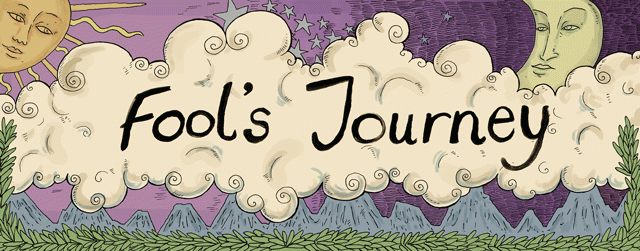
Header by Rory Midhani
Tarot is symbolic. Whether we’re looking at the pictures themselves and interpreting the things we see in them, or or turning archetypes or themes into metaphors in our own lives, to ‘read’ a tarot card is to translate a language of symbols into something familiar, making sense of our lives, and articulating the often inexplicable.
Vancouver-based poet Leah Horlick’s book of poems For Your Own Good uses that symbolic language as a vehicle to express some of the most traumatic experiences of her life. These poems tell the story of an abusive relationship and its aftermath, often using tarot cards and tarot symbolism to do so. In certain poems, the symbolism of tarot is used to describe feelings of betrayal, pain, freedom, the way the memory of the pain can linger, and tarot cards appear physically in these poems, too.
It’s heartbreaking, powerful, and a difficult read but, like so many tarot stories, it ends on note of transformation and liberation.
In the canon of contemporary feminist and lesbian poetry, For Your Own Good breaks silence. A fictionalized autobiography, the poems in this collection illustrate the narrator’s survival of a domestic and sexual violence in a lesbian relationship. There is magic in this work: the symbolism of the Tarot and the roots of Jewish heritage, but also the magic that is at the heart of transformation and survival.
Caitlin Press
After reading For Your Own Good, I asked Leah a few questions about what some of the tarot references in her poems mean to her.
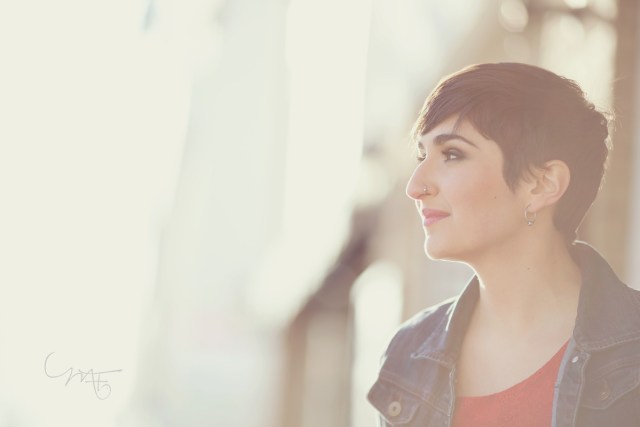
As a poet, you’re incredibly adept at describing experiences and moments through shards of memory, symbolism, imagery. For me, tarot does the same thing, articulating the inexpressible by showing me fragments of my experience which I can weave together into a story. Putting the subject matter in this book aside for a moment, can you explain how you approach and use tarot cards in your writing?
I think Tarot is an incredible tool for writers – for me, it’s as much about the symbols as it is about the arc of the suits and the Major Arcana. It took me a long time to start thinking of Tarot as a narrative – whether that’s how each suit contains a little story, or how the Major Arcana illustrates a classic hero’s journey or mythic tale, and even the micro-cosmic moments in the symbols of each card.
I have always struggled with structure and narrative as a writer, and the Tarot helped me map out the emotional journey of my narrator (and clearly, myself) right down to the placement of individual poems in the book. It’s about having a reflecting pool for the work – Michelle Tea says in How To Grow Up that a good Tarot reading will tell you what you already know, and I find a lot of my writing process is about that refining and reflecting.
On a more relaxed level, there are also just a myriad of ways that writers who are feeling blocked or stuck can use Tarot as prompts, and I think there’s something really powerful about tapping into systems of symbols that are so old and enduring. And most of all, because I think a lot of challenges to our creativity come out of our own personal patterns or roadblocks in our own lives, the Tarot is an incredible personal tool to work through those artists’ challenges on a personal level.
Can you tell us a little about your relationship with tarot during the years of this relationship?
I had been playing around with my first deck all through high school and was very witchy as a teen (classic, I know), but a big part of that first relationship was losing many of those aspects of myself – I wasn’t reading Tarot, or hardly even reading books at all. I didn’t have a lot of time alone and I also didn’t make a lot of time alone, like many survivors – knowing probably that if I gave myself a spare second to think about what was happening I’d have to make some major changes in my life and attend to some awful patterns. Returning to Tarot was a big part of returning to myself after that relationship, and healing.
In ‘Suit of Feathers’ your narrator mentions hiding a deck of cards beneath the bed, where her partner can’t find them. Did your ex-partner ever know that you used tarot?
That particular moment is a bit of a metaphor, but to be honest, I’m not sure if anyone other than one or two very close friends knew that I was interested in Tarot at the time.
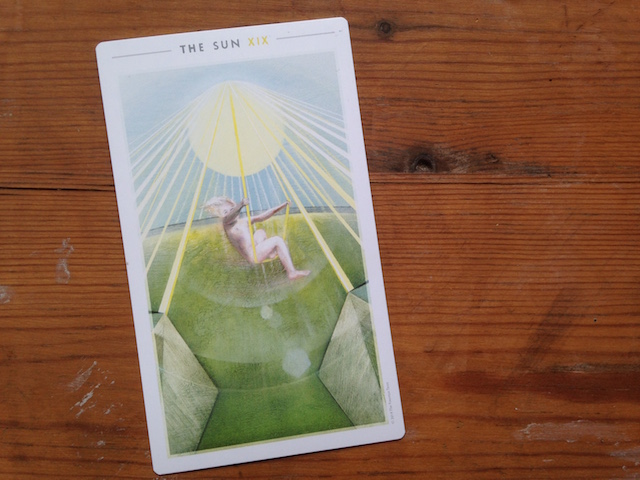
The Sun, from The Fountain Tarot
Let’s talk about some of the individual poems…
The Sun
… Or you ride your bike, remember
your legs. Find the one hill in town and canter
to its nape, lie slant in the grass until sweatpools at your clavicle. You draw the Sun card over
and over, and again on your body.
This is such a beautiful, free-feeling moment, exactly how I imagine The Sun to feel. That ‘stepping out of darkness into light,’ or the freedom to experience simple, beautiful things like sunshine on your skin. This is in stark contrast to the darkness and pain in most of your poems.
How did you feel about The Sun card generally at that time — was it something you longed for, or that only felt significant in those sacred alone-moments?
One of the most painful – and important – parts of writing this work was realizing that for it to be a complete narrative (and a true reflection of this experience), I was going to have to revisit not only some of the most violent and difficult memories I have, but also the beautiful and intimate moments that were still happening in my life while I was in an abusive relationship.
I was fortunate to still have moments of honest and gorgeous connection with friends, with myself, and – of course – even with my partner at the time, because that’s how abuse sustains itself, right? You wouldn’t still be there if there weren’t a couple of moments in the thread of the relationship where you felt (however fleetingly) good, even if it’s the fucked-up kind of good. And it wouldn’t be so damn hard to leave if there weren’t moments that also felt good and healthy and inexplicably hopeful. I have some amazing memories of that relationship. Some of that, I’m sure, was as much dopamine and adrenaline as it was genuine connection. This poem was where I really started to dig in to those good memories. For whatever reason, I have an incredibly vivid memory of this moment – it was a real turning point in my relationship with myself and also the first positive observation from a housemate/witness in a long time, and when I was trying to title it (always a challenge), The Sun seemed like the clearest emerging symbol. This was an interesting moment for me as well as a Tarot reader (I still use that term so grudgingly – you’d think it wouldn’t be so hard! I work with writers who don’t want to call themselves writers all the time! Self-doubt rears its familiar head again!)
Often I think as Tarot fiends or witchy folks we have these ideas of the “good cards” – you know the ones I mean. We want readings that are all Ace of Cups all the time. With this book, I had an amazing opportunity to develop positive relationships with so many of the classically negative cards — some visibly through The Tower, and Seven and Nine of Swords (‘Seven of Swords’ was actually the working title of the book for a long, long time) and invisibly through influences like the Death card. The Sun poem was the first moment in a long writing process where I felt able to highlight a truly, 90% positive yeah-yeah-yeah moment in the book – not the horrible “I hate the healing process and this sucks but is necessary” moments. I was so glad for this memory. And particularly, because so much of my healing process was spending a lot of time with some incredible pain, it was so powerful to have this memory of feeling really good in my body that, for a moment, didn’t have anything to do with sex. I didn’t draw the card all over my body literally, but once I restored that connection between the memory and the energy of the card, I sure felt like it.
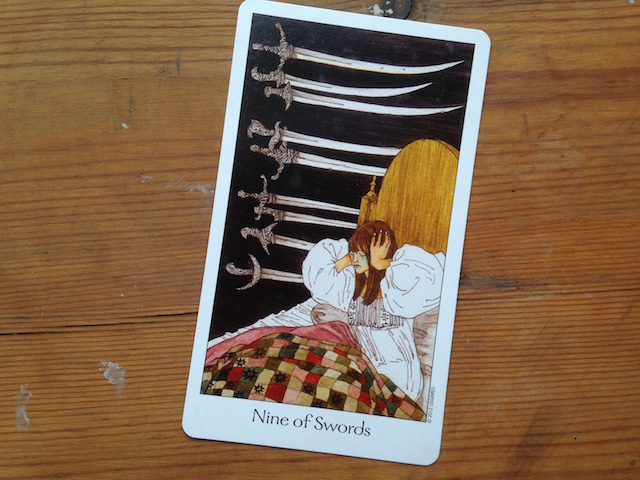
Nine of Swords, from the Dreaming Way Tarot
Nine Swords
He was into it. You were too. Don’t lie. And me,
half-asleep, resistant still. Good job, body-
this body, your secret, your shadow.… What I do and don’t remember: easing myself down
your stairs in the morning, that your hands were painful, that it wasmy fault. It was always my fault.
I often read the Nine of Swords lightly — as in, it’s about fears and nightmares, but largely, these are ‘in your head,’ made bigger by the fact that it’s the middle of the night, or because you feel powerless.
Your poem — which describes a rape, and the moment that rape was named — blows this out of the water. Here is a true waking and sleeping nightmare, the tangle of what you can and can’t remember, the flashbacks. Of all the cards in the deck, is this the one you associate most closely with trauma?
It’s interesting because Nine of Swords has so many different readings – I have so much affection for the Nine of Feathers interpretation in the Collective Tarot, which is more about self-harm and our own roles in perpetuating our own pain. For me, the Nine of Swords here is at play both as the actual moment, but also the resurfacing of this memory. So much of my experience came back to me through nightmares – once I moved out on my own, I had this horrific series of nightmares where my partner would almost hit me and I would wake up, and I remember one night going through all of my journals after waking up, knowing that I must have written something down about this somewhere and re-discovering all this writing about some of the earliest instances of sexual assault in the relationship – so early on, within the first couple weeks of dating. Repression and denial are truly amazing functions of our brains. It was such a powerful moment when I revisited traditional decks and rediscovered the imagery of the woman sitting up in bed with the swords hanging over her. I was like, that’s me. There we go. And this poem, quite truthfully, slid right under the radar and made it into the book at the last minute.
Huge gratitude to my editor Rachel Rose who was able to ask me some beautiful, intimate, survivor-centered questions that drew out an opportunity in the narrative – and consequently drew this memory out. This was a real turning point for me as a woman-to-woman survivor; even when I was coming out about the experience of lesbian sexual assault, I hardly ever mentioned this particular moment because I was afraid it would be too easy for folks. Too easy to boil down to the involvement of the perpetrator’s male friend, when in fact this was her pattern. And too easy to laugh off, because of the explicit use of the word rape. (If I admitted to not even believing myself at first, who would?) Now, of course, this is one of the poems I am the most proud of and one of the most important moments in the book.
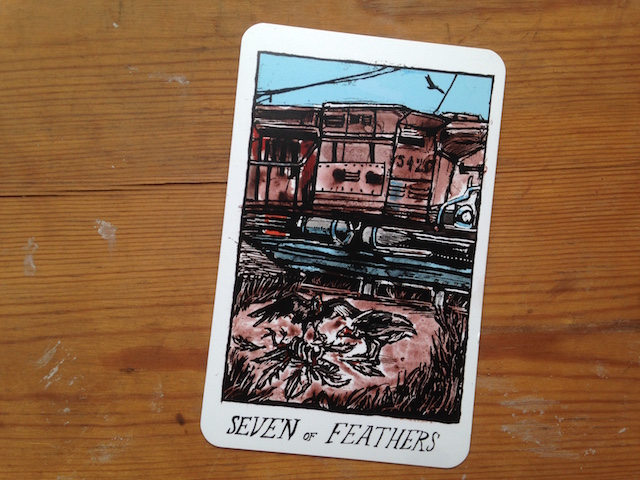
Seven of Feathers, from The Collective Tarot
Suit of Feathers
6. Vulture
In the cards you hide from her under the bed,
you keep drawing seven feathers:two birds at feast on another, nearby
train tracks, the bones not yet clean.And then that other vulture, circling
in the corner – wheeling over trainswhile you are picked apart
by your own kind.
I’m intrigued by part 6 – Vulture. Who is the vulture in this story? I’m looking at the card right now and the vulture is so far away, so high in the sky. Are you standing back and watching yourself? Or is it someone else?
In this piece, the vulture is really less of a particular person than a voice or a chorus – so often, I think, survivors discover this multitude of voices inside themselves after experiencing trauma. The voice of internalized misogyny. The voice of the well-meaning friend. The voice of that line from a movie you saw years ago, or your great aunt, or whoever – all the subconscious messaging we absorb about what sexual assault is and the stigma around it.
In this poem, the vulture is carrying some of those voices, as well as the experience of disassociation – which can be such a powerful coping mechanism and a form of witnessing yourself, but also so dangerous and harmful when you don’t want to be dissociating.
Why, also, did you name this section of the book ‘Suit of Feathers’?
“Suit of Feathers,” for folks who don’t know, is how the Collective Tarot reframes the traditional suit of swords. (I’m always mixing it up with keys, or wands. Always!) It’s considered one of the most difficult suits – with energies mostly relating to conflict, communication, heartbreak, self-harm, and community. The long poem in this section is called “Suit of Feathers” for a bit of wordplay – sometimes long poems are called “suites,” and all the poems in this suite are named after birds, so it’s almost a suite of feathers.
Symbolically I also think the idea of a suit made out of feathers is powerful and resonates with a lot of other myths and collective imagery around flight, power, escape, and ascent/descent, which comes up later in the book. I chose it as the title for the whole section for a myriad of those reasons, and because I believe it does contain some of the most difficult energy in the book.
Seven of Swords
… You are not drunk enough
to forget your send-off of tears and Do whatever
you want in Europe, ok, whatever the Fuck You
want. You don’t.
Here, I’m reading about a power struggle, and the jealous, defiant expectation of betrayal from your ex-partner. Yet within the Seven of Swords there are also themes of doing what must be done even if it’s not ethically spot-on, and there’s often a feeling of the underdog reclaiming what is theirs, or scoring a hit against their oppressor. What does this card mean to you?
I love how “Seven of Swords” sounds, and after some difficult work I’ve come to love this card, too. I think for the narrator in this poem, there is a powerful choice being made about her own agency, taking a particular moral high road, some very early work about femme gender in queer spaces, and also a sense of loss related to the imagery of the card – that scene of someone carrying away all their swords but one or two, and looking back, unsure of how much they can carry.
The Tower
… You can stand at the top of the castle, look out over
the orange tiles and cry about your body, what you will return to,
the way she’s been hurting you, how you know it has to stop.
As tarot readers, we usually imagine The Tower as a structure that has been dismantled, or rather, blown apart, by a sudden lightening bolt, a terrible shock. You turn that on its head in this poem, where you climb the tower itself and gaze out over rooftops. Here, the tower becomes a vantage point from which you can gain clarity, and it feels like you’re coming to this realisation — maybe suddenly, maybe it’s been coming on for a while.
Traditionally we think of that lightning bolt or change being out of our control, perhaps coming to liberate us from something we’re trapped in. In your poem, it’s much more self-motivated. Was this a turning point for you? What does the tower in the poem represent?
I do think there is a lightning-bolt moment in this poem, but it’s without the traditional imagery. Here, I think it’s the experience of connecting with collective or ancestral memory, as well as the lightning bolt of realization that can come from true distance or solitude.
A big part of my healing process was realizing that I have come from a very, very long line of women who have survived violence while everything around them was destroyed; women who have faced more denial and shame and danger than I could ever imagine. (I’m mixed race and my ancestors are Sephardic and Ashkenazi Jews, as well as so-called “Black Irish” folks who are mixed Spanish and Irish. Many of my Romanian Jewish relatives were displaced or murdered during the Holocaust; some of my dearest living relatives are survivors of labour camps and the Blitz who are descended from family who lived through pogroms and the Inquisition and so on.)
So much of my trip to Europe was remembering that history – I went to Prague, Berlin, Vienna, Budapest, and the former concentration camp at Dachau. I like your idea of turning the tower on its head – I think what’s also happening in this poem is a reframing or revealing of rites of passage for many young women – first love against sexual assault, travel against histories of genocide. The message of the Tarot that I most appreciate here is the possibility – possibility of rebuilding, recreating, and the creation that can come through destruction. Maybe rather than one lightning bolt, it’s a whole lightning storm.
Leah Horlick is a writer and poet from Saskatoon, currently living on Unceded Coast Salish Territories in Vancouver. Her first book, Riot Lung, was shortlisted for a ReLit Award and a Saskatchewan Book Award. She is a Lambda Literary Fellow, and Broken Pencil Magazine named her one of 10 artists to watch in 2015. She is quietly witchy, a nonZionist lesbian Jew, and one of her favourite projects is co-organizing REVERB – Vancouver’s only anti-oppressive queer reading series – with her bestie Esther McPhee. Visit her website or find her on Twitter.
For Your Own Good by Leah Horlick is published by and available from Caitlin Press, an indie publisher with a focus on LGBTQ and feminist books. If you’re in Vancouver, you can pick it up from Spartacus Book or Pulp Fiction.
If you want to read more about Leah’s experience of domestic violence between queer women, read this essay published by Autostraddle in 2013.

Wow. Leah Horlick is great. Love her poems! So neat that she was guided by tarot in her writing. Thank you for interviewing her Beth!
Whoa. This. Is powerful.
It is. The book itself is a difficult read, but the writing is incredible. I really recommend it.
Great interview!! I love Leah’s poems!
Right? I’ve just ordered another of Leah’s books, Riot Lung…
always love unique and personal takes on the cards- can so relate to the survivor POV.
Amazing interview, Beth. I can’t wait to read Leah’s poetry in full and think more about tarot and narrative and how it shapes writing. I have always wanted to write a play based on tarot, and this helped me clarify so many ideas.
Thanks – yeah, I’m similarly inspired to try writing some tarot poetry!